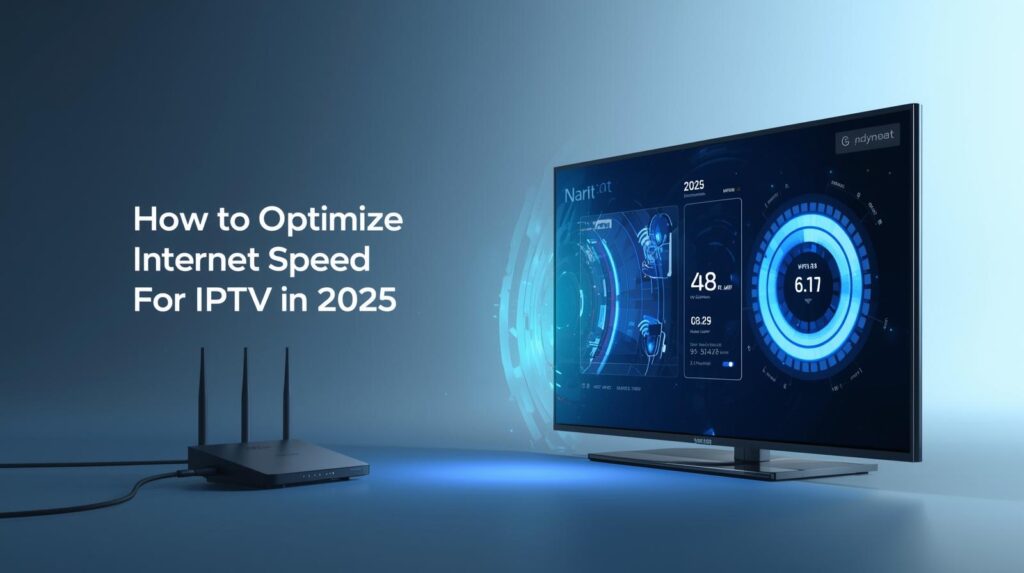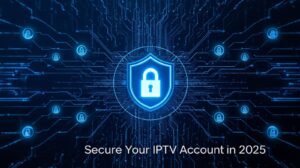IPTV has become one of the most popular ways to watch live TV, movies, sports and on-demand content. But no matter how good your IPTV subscription or app is, poor internet performance can ruin your experience. Buffering, freezing and low-quality streams are usually caused by insufficient or unstable internet connections.
If buffering is your main issue, read this guide as well:
How to Fix IPTV Buffering & Freezing (2025 Guide)
This guide provides everything you need to know about optimizing internet speed for IPTV, including bandwidth requirements, Wi-Fi vs. Ethernet, ISP selection, router setup and device-specific optimizations.
Why Internet Speed Matters for IPTV
IPTV streams video data continuously over the internet. Unlike downloading a file, streaming requires a consistent connection with enough bandwidth. If your internet is too slow or unstable, you may experience:
- Constant buffering during live channels
- Freezing in high-definition or 4K UHD streams
- Audio-video lag or unsynchronized playback
- Crashes or app errors
Minimum Bandwidth Requirements for IPTV
The required speed depends on resolution and the number of devices:
Stream Type | Recommended Speed | Notes |
|---|---|---|
SD (480p) | 5 Mbps | Suitable for one device, standard TV quality |
HD (720p / 1080p) | 10–15 Mbps | Smooth playback for a single device |
Full HD (1080p+) | 15–20 Mbps | Recommended if multiple devices stream HD |
4K UHD | 25+ Mbps | Essential for 4K TVs or multiple streams |
Multi-Device Streaming | +10 Mbps per additional device | Streaming simultaneously requires cumulative bandwidth |
Pro Tip: Always aim for slightly higher speeds than the minimum to avoid interruptions during peak hours.
Wi-Fi vs. Ethernet: What Works Best for IPTV?
Wi-Fi Streaming
Wi-Fi is convenient but can be less stable than wired connections, especially for HD or 4K streams.
Advantages:
- Wireless convenience
- Works with Smart TVs, Firestick android Boxes, PCs and mobile devices
Disadvantages:
- Subject to interference from walls, other Wi-Fi networks or household devices
- Bandwidth is shared among multiple devices, which can cause lag
Wi-Fi Optimization Tips:
- Use 5 GHz frequency band for higher speed and lower interference.
- Place your router closer to your IPTV device.
- Avoid multiple HD streams on other devices during IPTV viewing.
- Upgrade to mesh Wi-Fi systems for large homes or areas with poor coverage.
Ethernet Streaming.
Ethernet provides the most stable and reliable connection, ideal for high-quality IPTV.
Advantages:
- Consistent, uninterrupted streaming
- Less interference and latency
- Essential for 4K UHD and multi-device setups
Disadvantages:
- Requires a wired connection, limiting device placement
- Less convenient than Wi-Fi
Recommendation: For IPTV devices like Firestick android TV Boxes and Smart TVs, use Ethernet whenever possible, especially for HD or 4K streaming.
ISP and Network Settings for Optimal IPTV
- Choose the Right ISP Plan
- Ensure your internet package meets IPTV bandwidth requirements.
- For households with multiple devices or 4K streaming, aim for 25–50 Mbps or more.
- Fiber-optic or high-speed cable connections are preferred over DSL for consistency.
- Upgrade Your Router
- A modern router can handle multiple devices and reduce buffering:
- Dual-band routers (2.4 GHz + 5 GHz)
- Wi-Fi 6 routers for higher throughput
- Avoid using routers more than 5 years old.
- Quality of Service (QoS) Settings
- QoS allows your router to prioritize IPTV traffic over other internet usage.
- Configure your router to allocate more bandwidth to streaming devices.
- This ensures uninterrupted live TV even if other devices are using Wi-Fi.
- DNS Settings
- Slow connections or ISP throttling can cause IPTV buffering.
- Changing DNS can improve streaming speed and reliability:
- Google DNS: 8.8.8.8 / 8.8.4.4
- Cloudflare DNS: 1.1.1.1 / 1.0.0.1
- Update DNS in your device settings or router for a system-wide improvement.
- Use a VPN (Optional but Recommended)
- Some ISPs throttle streaming traffic.
- Using a VPN can bypass ISP restrictions and maintain stable speeds.
- Select a fast VPN server close to your location to minimize latency.
- Avoid free VPNs as they can reduce speed instead of improving it.
Read More Here : Do You Need a VPN for IPTV? Pros & Cons Explained
Device-Specific Optimizations
Firestick / Android Box
- Prefer Ethernet connection for HD/4K content.
- Clear app cache regularly to prevent slowdowns.
- Use high-performance IPTV apps like Tivimate, IPTV Smarters or Nova Prime.
Smart TVs
- Update firmware and IPTV apps for compatibility and smooth playback.
- Use wired connections for large homes or HD/4K content.
- Reduce interference from other devices sharing Wi-Fi.
PC / Mac
- Close background apps consuming bandwidth (downloads, updates, streaming).
- Prefer Ethernet for HD/4K streams.
- Use IPTV players compatible with your OS like VLC, Perfect Player or Tivimate PC.
Advanced Tips for Maximizing IPTV Speed
- Prioritize Devices: Limit the number of devices streaming simultaneously for smoother playback.
- Router Placement: Keep routers elevated and away from thick walls, microwaves or cordless phones.
- Regular Maintenance: Restart your router weekly and update firmware.
- Use High-Quality IPTV Providers: Providers like Nova Prime IPTV maintain optimized servers for stable streaming.
- Test Speed Before Streaming: Use tools like Speedtest.net to ensure your network is performing at expected levels.
- Enable Multicast or IGMP Settings: Some IPTV streams require multicast support, which can be enabled in advanced router settings.
Troubleshooting Speed Issues
Even after optimization, some issues may persist. Common fixes:
- Buffering during peak hours: Use Ethernet or upgrade your plan.
- Video lagging on HD/4K streams: Lower the stream resolution temporarily.
- ISP throttling: Use VPN or change ISP plan.
- Multiple device usage: Pause other bandwidth-heavy activities.
Conclusion
A smooth IPTV experience depends on adequate internet speed, reliable devices and proper network configuration. By optimizing your Wi-Fi or Ethernet setup, adjusting ISP and router settings and choosing high-quality IPTV providers like Nova Prime IPTV, you can enjoy:
- HD and 4K UHD streaming
- Uninterrupted live TV, movies and sports
- Multi-device support for the whole household
With these optimizations, buffering, freezing and slow streams will become a thing of the past, allowing you to get the most out of your IPTV subscription in 2025.




